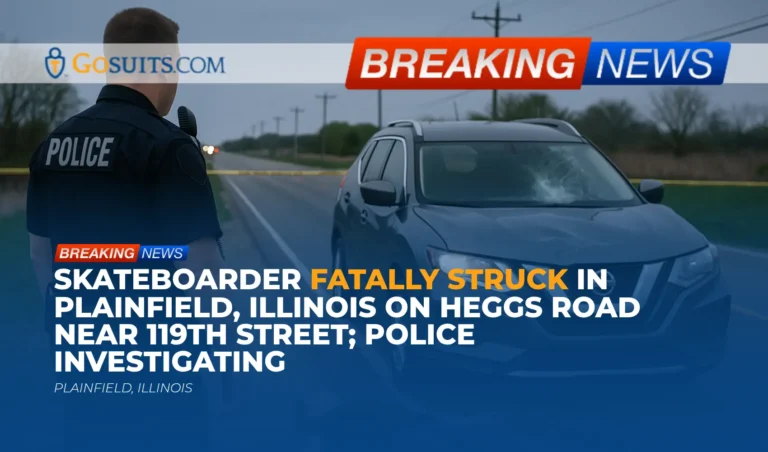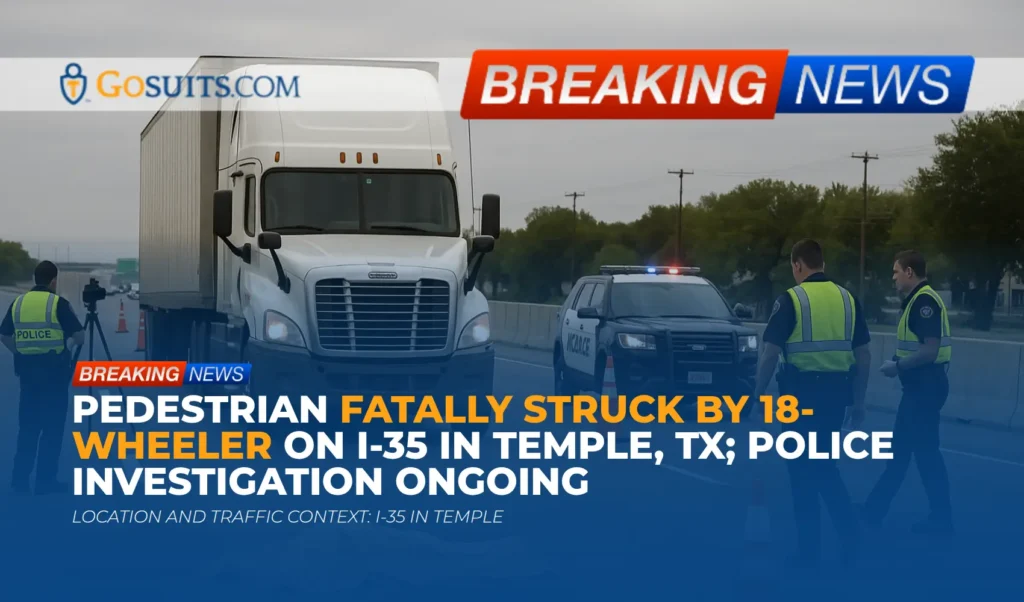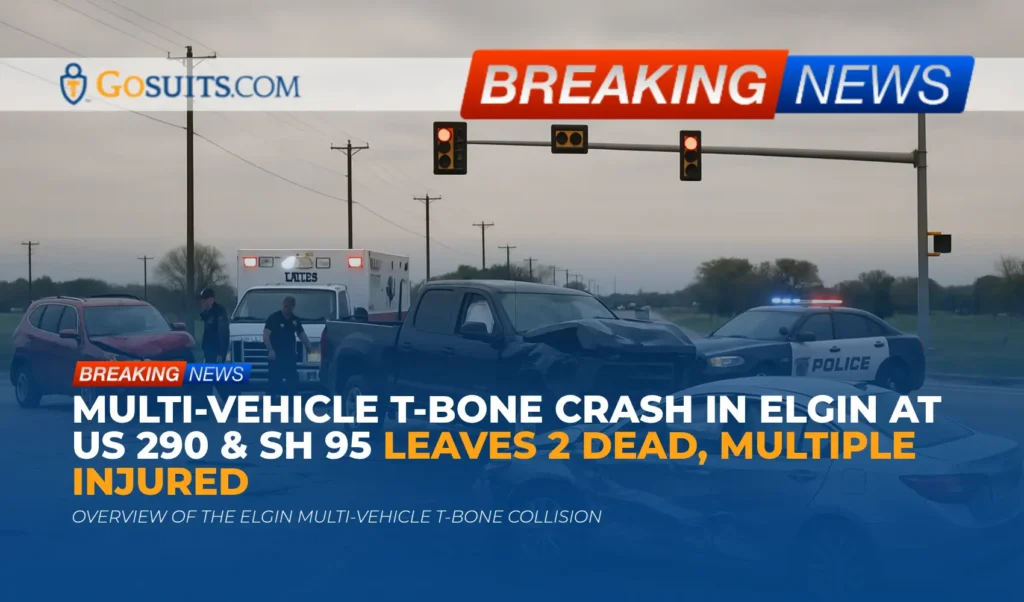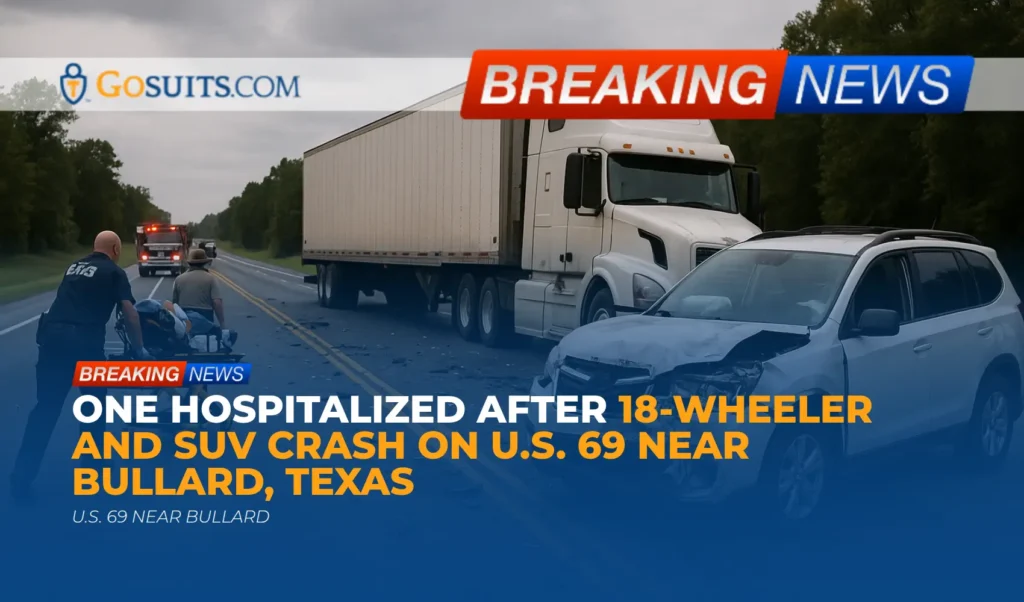- What happened on Heggs Road near 119th Street
- Where and when it occurred, and who is investigating
- Why roadway crashes involving people on skateboards can be severe
- Illinois rules that may be relevant in a civil claim
- How to obtain official records and documents
- Steps families commonly take after a fatal roadway incident
- Insurance considerations and protecting rights
- How fault is assessed and common defenses raised
- Community safety considerations for the Heggs Road corridor
- Support and grief resources
- Commentary from Gosuits Plainfield, Illinois Personal Injury Attorney
- Why taking action early matters after a serious crash
What happened on Heggs Road near 119th Street
Plainfield, Illinois police reported a fatal crash around 6:30 a.m. on Monday on Heggs Road near 119th Street. According to preliminary information released by the Plainfield Police Department, a person riding a skateboard and traveling south on Heggs Road was struck by a gray 2020 Nissan Rogue that was also traveling south. The rider, described as a male, was transported to Rush Copley Medical Center in Aurora and was later pronounced deceased. Officials stated the driver of the Nissan sustained non-life-threatening injuries and was transported for medical care. As of early Monday afternoon, officials noted that the driver was cooperating with the investigation and no citations or charges had been issued at that time.
Heggs Road was closed between 119th Street and 127th Street while officers investigated, and Illinois State Police assisted with crash reconstruction. Authorities indicated this was the second fatal crash in Plainfield within four days; on the prior Friday, a motorcycle rider died following a reported failure to yield at 119th Street and Route 30.
Plainfield Police asked anyone with information about Monday’s crash to contact Sgt. Dino Dabezic at 815-267-7238. The identity of the deceased person was withheld pending next-of-kin notification.
Where and when it occurred, and who is investigating
The collision occurred during the early morning hours near the intersection of Heggs Road and 119th Street in Plainfield. The time of day matters for investigators, who routinely consider lighting conditions, traffic flow during morning commutes, visibility, roadway layout, and whether any nearby construction or temporary traffic control devices may have influenced the scene.
The Plainfield Police Department remains the lead investigating agency. Illinois State Police assisted with crash reconstruction, a specialized investigative process that examines vehicle dynamics, scene measurements, roadway evidence, and other data to help clarify the sequence of events. Information developed through reconstruction can be highly relevant in later civil proceedings.
Why roadway crashes involving people on skateboards can be severe
People traveling outside of vehicles have little protection in a collision. National data shows that crashes involving pedestrians and other non-motorists frequently result in serious injury or fatality due to exposure to direct impact forces. The National Highway Traffic Safety Administration (NHTSA) reports that pedestrian fatalities have remained a persistent roadway safety challenge in recent years, with more than seven thousand pedestrian deaths annually nationwide. See NHTSA’s overview of pedestrian safety for context on risk and prevention strategies here.
While skateboards are not specifically enumerated in many crash databases, safety analysts often categorize riders among “non-motorists” or consider them within pedestrian risk discussions due to their vulnerability. Key factors that commonly influence severity include:
- Vehicle speed at impact. Higher speeds sharply increase fatality risk for unprotected road users, a trend consistently observed in safety research reported by transportation agencies.
- Conspicuity and lighting. Early morning conditions can reduce visibility, making clothing reflectivity, lighting, and headlamps a focus of investigation.
- Roadway design and traffic volume. Shoulder width, presence of sidewalks or paths, sightlines, and traffic control can all shape exposure and risk.
- Driver attention and scanning. Whether a driver perceived and responded to a person in time is a central question in many reconstructions.
Illinois rules that may be relevant in a civil claim
Duty to exercise due care toward people on or near the roadway
Illinois requires drivers to exercise due care to avoid colliding with any person on the roadway and to give warning when necessary. See 625 ILCS 5/11-1003.1 Duty of driver to exercise due care. This duty applies regardless of whether a person is walking, standing, or otherwise present in the roadway environment.
Speed, lane usage, and yielding
Speed and control rules can be central in evaluating a crash. Illinois law requires drivers to operate at a reasonable and proper speed under the conditions and to decrease speed as needed to avoid collisions, even if traveling below the posted limit. See 625 ILCS 5/11-601 General speed restrictions. Where intersections are involved, right-of-way and yielding rules become important; investigators compare scene evidence and statements with these statutory duties.
Comparative fault framework
In Illinois, civil claims are governed by modified comparative negligence. If a plaintiff’s share of fault is more than 50 percent, recovery may be barred; if 50 percent or less, recoverable damages are reduced by the plaintiff’s percentage of fault. See 735 ILCS 5/2-1116 Comparative negligence.
Wrongful death and survival claims
- Wrongful death. Illinois allows a civil action when a death is caused by a wrongful act, neglect, or default. See 740 ILCS 180/2 Wrongful Death Act.
- Survival claims. Certain causes of action the decedent could have brought during life may survive to the estate, such as claims for pain, suffering, and medical expenses incurred before death. See 755 ILCS 5/27-6 Survival Act.
Time limits to file
- General personal injury. Two years from the date of injury in most situations. See 735 ILCS 5/13-202 Limitations for personal injury.
- Wrongful death. Generally two years from the date of death, with specific exceptions in the statute. See 740 ILCS 180/2 Wrongful Death Act.
- Claims involving public entities. Shorter notice or filing deadlines may apply under the Local Governmental and Governmental Employees Tort Immunity Act. See 745 ILCS 10/8-101 Limitations.
Time limits can be complex; families often review circumstances with a qualified professional to avoid missing a deadline.
How to obtain official records and documents
Police crash report and supplemental materials
Crash reports are generally maintained by the responding agency. Here, the Plainfield Police Department is the primary point of contact. Families often request:
- Illinois Traffic Crash Report. The foundational incident report containing initial observations, involved parties, vehicles, and diagramming.
- Supplemental reports. Officer narratives, witness statements, and evidence logs, if releasable.
- Photographs and video. Scene photos and, if available, dash or body camera footage. Release can depend on the status of the investigation and applicable exemptions.
When records are not immediately released due to an open investigation, a request under the Illinois Freedom of Information Act (FOIA) may be filed. See 5 ILCS 140 FOIA statute. FOIA sets timelines and exemptions for public records requests. If the Illinois State Police assisted in reconstruction, technical reports or measurements may be maintained by ISP’s Traffic Crash Reconstruction Unit; inquiries can be directed to that unit once reports are finalized. For an overview of ISP’s crash reconstruction function, see ISP’s information page here.
Coroner and autopsy materials
In fatalities, the county coroner’s office typically determines cause and manner of death and may perform or oversee an autopsy. In Plainfield, this generally involves the Will County Coroner’s Office. Next of kin can usually request the following once available:
- Preliminary death notification. Basic information confirming the death.
- Autopsy report. Findings relating to injuries, cause of death, and contributing factors.
- Toxicology report. If testing was performed.
For obtaining certified death certificates, families can work through the county clerk or the Illinois Department of Public Health (IDPH) Vital Records program. IDPH provides guidance on death records and requirements here.

Medical records
Hospitals and emergency medical providers maintain treatment records. In this incident, care was provided at Rush Copley Medical Center. The legal next of kin or the estate’s representative would typically request the decedent’s records under HIPAA with proper authorization. These records document clinical findings, interventions, and timeline of care and can be vital in understanding injuries and pre-death pain and suffering.
Traffic signal timing, roadway data, and public infrastructure records
Depending on the exact location, roadway ownership may involve municipal, county, or state agencies. Families or their representatives sometimes seek:
- Signal timing logs and maintenance records. If signals or flashers are nearby.
- Road design plans and traffic counts. Helpful for understanding sight distance, speed environment, and pedestrian facilities.
IDOT publishes statewide crash facts and safety information which can provide context for roadway risk patterns, available through IDOT. Agency-specific records generally require requests to the agency that owns the road or equipment.
Steps families commonly take after a fatal roadway incident
Every situation is unique, and families move at a pace that respects their grief. The following steps are commonly helpful:
- Identify the investigating officer and report number. Note the Plainfield Police Department case number and contact. The agency asked tipsters to call Sgt. Dino Dabezic at 815-267-7238 regarding this crash; families often keep this contact nearby as updates develop.
- Preserve evidence early. Preserve clothing, skateboard, helmet or protective gear, and any damaged personal items in their post-incident condition. Photograph everything before handling if possible.
- Collect witness information. Keep names, phone numbers, and any statements from people who saw the event or its aftermath.
- Document expenses and communications. Organize funeral expenses, medical bills, and any insurance correspondence in a single file.
- Request official records methodically. Submit requests for police reports, medical records, and coroner documents when they are available.
- Consider retaining counsel before insurer discussions. Statements to insurers may be recorded and can influence claim outcomes later. Consulting with an attorney first can help avoid misunderstandings and protect rights.
Insurance considerations and protecting rights
Auto liability insurance is mandatory in Illinois, which provides a source of coverage for injuries and deaths caused by motor vehicle operation. See the Illinois Secretary of State’s overview of mandatory insurance requirements here. Depending on the facts, several insurance policies can be implicated:
- At-fault driver’s liability policy. Typically the primary coverage for wrongful death and survival claims.
- Underinsured motorist (UIM) coverage. If applicable within a household auto policy, it may supplement recovery when the at-fault driver’s limits are inadequate.
- Medical payments (MedPay) benefits. Some policies provide limited no-fault medical benefits to help with immediate medical or funeral expenses, subject to policy terms.
Before speaking with any insurance adjuster, it is prudent to consult an attorney. Insurance companies may request recorded statements, broad authorizations, or early releases. What is said to an insurer can be used later in ways that affect a claim. A free consultation can clarify rights and next steps without committing to a course of action.
How fault is assessed and common defenses raised
Illinois crash investigations and civil cases often turn on careful analysis of duties, conduct, and conditions at the time of the incident. Typical issues include:
- Driver attention and speed. Whether the driver maintained a proper lookout and controlled their speed given conditions is assessed using scene evidence, vehicle data, and witness accounts. See the general duty to avoid colliding with people on the roadway at 625 ILCS 5/11-1003.1 here and speed obligations at 625 ILCS 5/11-601 here.
- Visibility and lighting. Dawn lighting, glare, weather, and roadway geometry can influence perception and reaction time.
- Lane position and roadway use. Investigators examine where each person was within the roadway environment and whether movements were reasonably predictable to others.
- Comparative negligence arguments. Defense counsel may argue that a non-motorist’s actions contributed to the event. Under 735 ILCS 5/2-1116 comparative negligence, any allocation of fault can reduce recoverable damages, and a finding above 50 percent bars recovery.
Crash reconstruction data, including vehicle damage profiles, skid or yaw marks, and time-distance analysis, often plays a significant role in resolving these questions. The Illinois State Police Traffic Crash Reconstruction Unit maintains specialized capabilities for these investigations, discussed by ISP here.
Community safety considerations for the Heggs Road corridor
Heggs Road near 119th Street is a commuting route for drivers in and around Plainfield. While the details of this crash remain under investigation, safety professionals commonly evaluate corridors like this for:
- Availability and condition of sidewalks or shared-use paths. The presence of safe space for people outside vehicles influences exposure to traffic.
- Lighting and visibility. Early morning travel places a premium on roadway illumination, headlight use, and reflectivity of clothing or equipment.
- Speed management. Actual operating speeds relative to the posted limit and surrounding land uses.
- Warning signage and markings. Crosswalks, advisory signs, or other traffic control devices that promote awareness of people traveling outside vehicles.
Broader crash data and trends published by IDOT can help communities assess risk and prioritize improvements, accessible through IDOT’s crash information page here. NHTSA provides national-level safety guidance on reducing pedestrian and non-motorist risk here.
Support and grief resources
Sudden loss is overwhelming. Many people find it helpful to talk with a counselor, faith leader, or a trained professional. National and state resources include:
- 988 Suicide & Crisis Lifeline. Call or text 988 for 24/7 emotional support. Program information is maintained by SAMHSA here.
- SAMHSA’s Disaster Distress Helpline. 800-985-5990 connects callers with crisis counseling and support here.
Local hospitals and community organizations often have grief support groups as well. Participation can be arranged when the family is ready.
Commentary from Gosuits Plainfield, Illinois Personal Injury Attorney
Our hearts are with the family and friends affected by the loss reported on Heggs Road. What follows is general information offered for educational purposes in the midst of a difficult moment for the Plainfield community.
When a person outside a vehicle is struck by a car moving in the same direction, the questions we look at include visibility, speed relative to conditions, and the driver’s duty to keep a careful lookout and avoid collisions. Early-morning lighting, sightlines, and roadway configuration can all factor into whether a collision was preventable. A thorough reconstruction often clarifies time, distance, and perception-response opportunities for everyone involved.
In our experience, insurance carriers and corporate risk departments quickly mobilize after serious crashes. They may request recorded statements, broad medical authorizations, or early settlement discussions before a full set of facts is available. That imbalance of information can leave families vulnerable to decisions that affect their rights later. Knowing what to share, when, and with whom can make a measurable difference.
A free consultation gives families a calm space to understand potential claims, applicable deadlines, and next steps without pressure. It also helps ensure that critical evidence is preserved while memories are fresh and records are still readily available.
Why taking action early matters after a serious crash

What to do
- Secure the official case information. Identify the investigating agency, case number, and designated point of contact. Maintain a single file for all documents and updates.
- Preserve physical evidence. Store the skateboard, clothing, helmet, and any damaged personal items in a dry, secure place. Avoid cleaning or repairing anything until it has been documented.
- Organize records. Keep medical bills, funeral invoices, and correspondence from insurers together. Date-stamp notes of every call or conversation.
- Request records methodically. Ask the police department about the crash report timeline; request coroner and medical records when available; consider FOIA requests if needed under Illinois law.
- Consult before speaking with insurers. Seek a free consultation with a seasoned attorney before providing any recorded statement or signing any releases. Statements given to insurers can be used later and may affect claim outcomes.
Why it matters now
- Evidence can be lost quickly. Skid marks fade, video overwrites, and memories dim. Early preservation protects the truth of what happened.
- Deadlines apply. Illinois law imposes time limits for civil claims, often two years in wrongful death cases, with different deadlines when public entities are involved Wrongful Death Act and Tort Immunity Act.
- Insurers move quickly. Early outreach by adjusters is common and can influence the trajectory of a claim. Informed decisions at the outset can prevent missteps.
- Clarity helps with healing and planning. Understanding the process, what information to expect, and how fault is evaluated can provide direction during a disorienting time.
Where to focus
- Investigating agency coordination. Maintain respectful, periodic contact with Plainfield Police for status updates. Note that release of some records may await completion of the investigation.
- Coroner communication. Ask the county coroner’s office about availability of autopsy and toxicology reports and the process for obtaining certified death certificates, with general guidance from IDPH here.
- Legal roadmap. A brief, no-cost consultation can outline potential claims, available coverages, and a plan to gather and safeguard evidence without delay.






